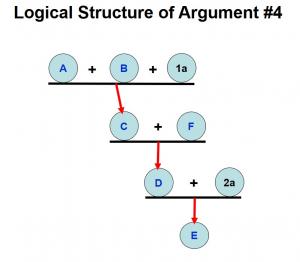Kreeft’s Case for God – Part 17: Analysis of Argument #4
MOVING ON TO KREEFT’S VERSION
In Peter Kreeft’s case for God, in Chapter 3 of Handbook of Christian Apologetics (hereafter: HCA), his fourth argument is based on the fourth way of Aquinas. Kreeft’s Argument #4 is the Argument from Degrees of Perfection. Because Aquinas’s version of this argument is clearer and more straightforward than Kreeft’s version, I began by analyzing and evaluating Aquinas’s fourth way (see Part 16 of this series). I discovered some serious problems with Aquinas’s version of this argument, and rejected that argument. It is now time to try to analyze and to understand Kreeft’s version of this argument.
THE INITIAL INFERENCE IN ARGUMENT #4
An important part of Argument #4 is implied by a single complex sentence in Kreeft’s presentation of this argument. Let’s call this premise (1):
1. But if these degrees of perfection pertain to being and being is caused in finite creatures, then there must exist a “best,” a source and real standard of all the perfections that we recognize belong to us as beings. (HCA, p.55)
Premise (1) can be cleaned up a bit, to make it more succinct:
1a. IF these degrees of perfection pertain to being and being is caused in finite creatures, THEN there exists a source and real standard of all the perfections that pertain to being.
The word “But” at the beginning of the sentence is unnecessary. The word “must” simply indicates a logical implication, and so it is unnecessary. The phrase “a ‘best'” is unnecessary because it is immediately defined by the following phrase “a source and real standard of all the perfections…”. The phrase “that we recognize belong to us as beings” can be replaced by the shorter phrase “that pertain to being”.
Premise (1a) has the following logical structure:
IF A and B, THEN C.
This suggests the logical structure of a key initial inference in Argument #4:
A
B
IF A and B, THEN C
THEREFORE:
C
Let’s put the appropriate statements into this structure:
A. These degrees of perfection pertain to being.
B. Being is caused in finite creatures.
1a. IF these degrees of perfection pertain to being and being is caused in finite creatures, THEN there exists a source and real standard of all the perfections that pertain to being.
THEREFORE:
C. There exists a source and real standard of all the perfections that pertain to being.
THE FINAL INFERENCE IN ARGUMENT #4
Kreeft’s versions of the Five Ways of Aquinas, especially Ways 1, 2, 3, and 5, are all complete FAILURES, because Kreeft does not bother to support the most important premises in those arguments, namely the premises that link the existence of some alleged metaphysical being (e.g. “unmoved mover” or “first efficient cause”, etc.) to the existence of God. Kreeft hints at the most important premise of Argument #4 in another sentence; let’s call this premise (2):
2. This absolutely perfect being…is God. (HCA, p.55)
This most important premise of Argument #4 is best stated as a conditional claim:
2a. IF an absolutely perfect being exists, THEN God exists.
This conditional claim is a key piece of the final inference in Argument #4:
2a. IF an absolutely perfect being exists, THEN God exists.
D. An absolutely perfect being exists.
THEREFORE:
E. God exists.
THE LOGIC IN THE MIDDLE OF ARGUMENT #4
We now know the initial inference of Argument #4, i.e. the sub-argument for (C), and we know the final inference of Argument #4, i.e. the sub-argument for (E), but we are missing the logic in the middle of this argument, the connection between the initial inference and the final inference.
The connection is clearly that premise (C), the conclusion of the initial inference, provides support for premise (D), a premise in the final inference. Since it is not immediately obvious that (C) logically implies (D), we should explicitly state a premise that asserts that there is this logical relationship between (C) and (D):
F. IF there exists a source and real standard of all the perfections that pertain to being, THEN an absolutely perfect being exists.
So, the logic in the middle of Argument #4 goes like this:
F. IF there exists a source and real standard of all the perfections that that pertain to being, THEN an absolutely perfect being exists.
C. There exists a source and real standard of all the perfections that pertain to being.
THEREFORE:
D. An absolutely perfect being exists.
THE LOGICAL STRUCTURE OF ARGUMENT#4
Now we can show the full logical structure of Argument #4, especially how the initial inference is connected to the final inference by an inference in the middle of this argument (click on the image below for a clearer view of the argument diagram):
Note that out of the eight statements that make up this argument, only two statements were made explicitly by Kreeft. Three-fourths of this argument was left UNSTATED. Not exactly a great job of clarifying the Fourth Way of Aquinas.
NEXT STEPS
Now that we know the logical structure of Argument #4, the next steps are to figure out the meanings of the premises of this argument:
- What is a “perfection”?
- What sort of perfections are those that “pertain to being”?
- What is a “finite creature”?
- What does it mean to say that “being is caused in” something?
- What is an “absolutely perfect being”?
- What constitutes “a source and real standard” of a perfection?
There is not a SINGLE premise in Argument #4 that has a CLEAR meaning. Each and every premise in this argument uses odd or technical terms, and is thus UNCLEAR as it stands.

